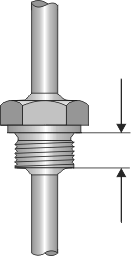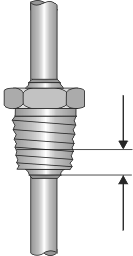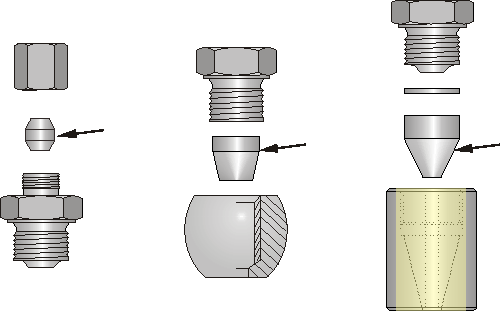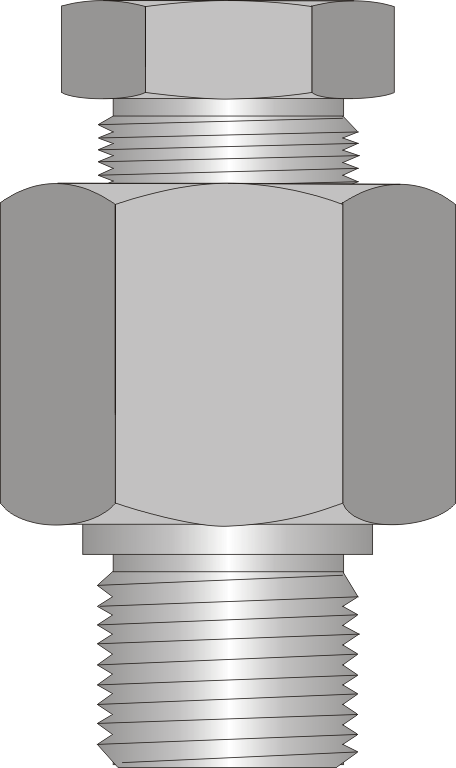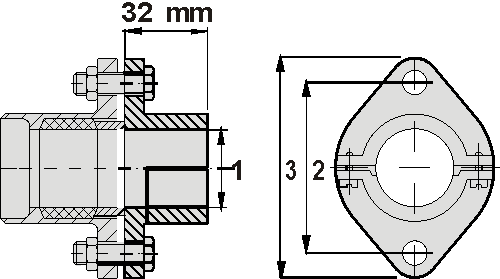Process connections and Materials | ||||||||||||||||||||||||||||||||||||||||||||||||||||||||||||||||||||||||
|
The process connection is the connection between the thermometer and the process (pipes, tanks, etc). The following process connections are divided into:
|
||||||||||||||||||||||||||||||||||||||||||||||||||||||||||||||||||||||||
| Threads |
|
| ||||||||||||||||||||||||||||||||||||||||||||||||||||||||||||||||||||||
|
Note:: Generally cylindrical and conical threads are distinguished.
|
|
| ||||||||||||||||||||||||||||||||||||||||||||||||||||||||||||||||||||||
|
|
|
|
||||||||||||||||||||||||||||||||||||||||||||||||||||||||||||||||||||||
|
Compression fitting |
|
|
||||||||||||||||||||||||||||||||||||||||||||||||||||||||||||||||||||||
|
PTFE/Viton ferrule: Note:
|
|
|
||||||||||||||||||||||||||||||||||||||||||||||||||||||||||||||||||||||
|
|
|
|
||||||||||||||||||||||||||||||||||||||||||||||||||||||||||||||||||||||
|
316/1.4401 ferrule: Note:
|
||||||||||||||||||||||||||||||||||||||||||||||||||||||||||||||||||||||||
|
Gas tight adjustable threaded bush for high temperature thermocouples |
|
|
||||||||||||||||||||||||||||||||||||||||||||||||||||||||||||||||||||||
|
Note:
|
|
|||||||||||||||||||||||||||||||||||||||||||||||||||||||||||||||||||||||
|
|
||||||||||||||||||||||||||||||||||||||||||||||||||||||||||||||||||||||||
|
Flange |
||||||||||||||||||||||||||||||||||||||||||||||||||||||||||||||||||||||||
|
Flanges offer the process connectionsch of field devices. They are subject to the EN, AMSE or JIS standards and are divided by material, nominal diameters, seal face and nominal pressure ranges. In order to cover all the various types of process conditions a large number of sealing possibilities are available: Tongue and groove flange Male/ female raised face
flanges Flat faced flange Gasket guide flange |
|
|||||||||||||||||||||||||||||||||||||||||||||||||||||||||||||||||||||||
| (1) typical PN 2,5 bis PN 40 (2) typical PN 63 und PN100 |
||||||||||||||||||||||||||||||||||||||||||||||||||||||||||||||||||||||||
|
Flange for high temperature thermocouples |
||||||||||||||||||||||||||||||||||||||||||||||||||||||||||||||||||||||||
|
Highest temperature 350 °C, material aluminum. No gas tight connection. Selection in the order code. Flange outer diameter 70mm Thermometer fixing via side mounted clamping screw. |
|
|||||||||||||||||||||||||||||||||||||||||||||||||||||||||||||||||||||||
|
|
||||||||||||||||||||||||||||||||||||||||||||||||||||||||||||||||||||||||
|
Highest temperature 400 °C,
material cast iron. No gas tight connection. Matching
flange and gasket not delivered. Must be added to the
order structure as a special option. |
|
|||||||||||||||||||||||||||||||||||||||||||||||||||||||||||||||||||||||
|
Material availability
guide |
|
|
Material |
Composition |
Max temperature |
Application |
|
304SS |
18% Chromium |
650 °C (800 °C pressureless in air) |
Offers excellent restistance to many corrosive agents encountered in domestic and industrial use. |
|
310SS |
25% Chromium |
1150 °C |
Good resistance to oxidation at temperatures up to 1150 °C. Good resistance to thermal fatigue and cyclic heating. |
|
316SS |
17% Chromium |
650 °C (800 °C pressureless in air) |
Good resistance to a much larger range of chemicals than 304SS. Withstands sulphurous acid compounds. |
|
321SS |
Similar to 304SS but Steel stabilized by Titanium addition |
650 °C (800 °C pressureless in air) |
Not sensitive to intergranular corrosion when heated within the carbide precipitation range of 482 °C to 800 °C. Similar to 304SS in corrosion resistance. |
|
347SS |
Similar to 304SS but contains Tantalum and is Steel stabilized by Columbium addition |
650 °C (800 °C pressureless in air) |
Exactly equivalent to 304SS for 426 °C to 800 °C range. Superior to 321SS where service is both corrosive and at an elevated temperature. |
|
304LSS/316LSS |
Similar to 304SS and 316SS but with reduced carbon (low carbon) |
650 °C (800 °C pressureless in air) |
Low carbon versions of 304SS and 316SS (maximum of 0.03% carbon). Because of low carbon content the effects of carbide precipitation are reduced. |
|
Inconel 600 |
76% Nickel |
1100 °C |
Excellent material for severely corrosive environments. Resistant to oxidation at temperatures up to 1100 °C. Excellent for cement plants. |
|
Inconel 601 |
60.5% Nickel |
1100 °C |
Similar to Inconel 600 however higher Chromium content gives superior resistance to oxidizing, carburizing and sulphur containing environments. |
|
Incoloy 800 |
32.5% Nickel |
1100 °C |
Resistant to oxidation and carburization at elevated temperatures. It resists stress-corrosion cracking, sulphur attack, internal oxidation, scaling and corrosion in a wide variety of indstrial atmospheres. Sulphurous applications. |
|
Monel 400 |
66% Nickel |
550 °C |
Highly resistant to corrosion by chlorinated solvents, glass etching agents, Sulphuric and many other acids and practically all alkalies generally free from stress-corrosion cracking. Good resistant to salt water corrosion. Desalination plants. |
|
Hastelloy B |
61% Nickel |
1100 °C |
Good corrosion resistance to hydrochloric, sulphuric, phosphoric and acetic acids. Excellent corrosion resistance to hydrogen-chloride gas. |
|
Hastelloy C |
54% Nickel |
1100 °C |
Good corrosion resistance to many chemical environments, including ferric and cupric chlorides, contaminated mineral acids, wet chlorine gas. Oxidation resistance to 1100 °C. |
|
Hastelloy X |
47% Nickel |
1100 °C |
Good high temperature strength and resistance to oxidation to 1100 °C. Also good for reducing conditions. |
|
F11 chrom moly |
0.5% Molybdenum |
550 °C (650 °C pressureless in air) |
High strength steels used in pressure vessels and industrial boilers. Resistant to cleaning agents, chloroform, food products and carbon disulphide. The chrom moly is generally matched to the pipe grade for optimized welds. |
|
F22 |
1.0% Molybdenum |
600 °C |
High strength steels used in pressure vessels and industrial boilers. Resistant to cleaning agents, chloroform, food products and carbon disulphide. F22 has a higher tensile strength than F11. The chrom moly is generally matched to the pipe grade for optimized welds. |
|
F91 |
1.0% Molybdenum |
600 °C |
High strength steels used in pressure vessels and industrial boilers. Resistant to cleaning agents, chloroform, food products, carbon disulphide. F91 has one of the highest available tensile strengths for chrom moly steels. The chrom moly is generally matched to the pipe grade for optimized welds. |
|
HR160 |
29% Cobalt |
1200 °C |
A high temperature alloy with outstanding resistance to high temperature corrosion. It has excellent resistance to sulphidation and chloride attack in both reducing and oxidizing atmospheres. Its resistance to attack by the products of combustion of low grade fuels makes it VERY useful in municipal, industrial, hazardous and nuclear waste incinerators. |
|
Titanium |
Ti metal |
600 °C |
Excellent resistance to oxidizing acids such as nitric or chromic. It is also resistant to inorganic chloride solutions, chlorinated organic compounds and moist chlorine gas. Its good resistance to seawater and salt spray allows it to be used in offshore installations. |
|
Duplex stainless steel 2205 |
4.5% Nickel |
300 °C |
These grades combine high strength with excellent corrosion resistance, especially to chloride stress corrosion cracking. However a tendency to brittleness limits their use to approx. 300 to 315 °C maximum. Sub-zero use is also restricted because of brittleness due to ferrite content. Offshore pipelines are the main applications. |
